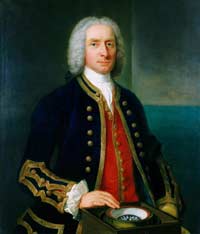A Cautious Beginning:
The Court of Civil Jurisdiction 1791
by Christopher English and Christopher Curran
Ignoring Statute:
The 18th Century Indigenous Regime
As part of the enhanced power of the commander of the summer naval
contingent, upgraded from an appellate to a civil gubernatorial jurisdiction,
Captain Henry Osborn in 1729 appointed 16 justices of the peace and 13
constables to 11 centres in six districts stretching from Placentia to
Bonavista.16
|
Captain Henry Osborn, n.d.
As Commander of H.M.S. Squirrel Osborn was appointed first Governor
of Newfoundland. He served as Governor from 1729-1730.
Detail from a painting by Claude Arnulphy. Licensed under Public Domain via Wikimedia Commons
 with more information (51 kb). with more information (51 kb).
| |

|
At the same time he delegated power to subordinate naval
officers to act as surrogates. On its face neither appointment was inconsistent
with the Act of 1699 as long as the justices of the peace restricted their
activities to the winter and as long as the naval presence in Newfoundland was
seasonal. But in practice the availability of these alternative sources of justice,
notably the governor's surrogates, was, according to Reeves, "flown to by the poor inhabitants and planters as the only refuge that they had from the West Country merchants, who were always their creditors, and were generally regarded as their oppressors". The magistrates may have been "but mean people and not used to subject to any Government", according to Osborn.17 That may have been a problem for Osborn, but it suggests that the magistrates were prepared to navigate by their own lights and were applying local conceptions of justice. Fifty years later Reeves noted the magistrates' inadequate training and skills, and their vulnerability to the influence of the local merchant. But he sought not their abolition but their improvement via an infusion of fresh personnel and decent
salaries.18 He and his successors ridiculed the inadequacy of Osborn's having equipped each centre with a copy of Shaw's Punctual Justice of the Peace, each embossed in gold with the name of the community, and with copies of the 1699 statute and further Acts on trade and navigation.19
But they were practical aids and probably marked a quantum leap from what the fishing admirals had had at their disposal. Undoubtedly the magistrates met a need. Sitting in Courts of Session year round they acted to resolve local disputes and have enjoyed an unbroken tenure to the present day.
 |
Judicial Proceedings Notice
During his term as governor, Osborn appointed justices of the peace and
constables to a number of centres.
Courtesy of The Rooms Provincial Archives Division (PANL GN 5-4-B-1), St. John's, NL.
 with more information (33 kb).
with more information (33 kb). |
Governor Osborn also moved to fill the statutory gap with regard to
enforcement. He constructed stocks, whipping posts and a prison in St. John's.
Another was planned for Ferryland. From the first the requirement that those
charged with capital offenses be sent to England appears to have been
ignored. This was reflected in the Board of Trade's proposal for a criminal court
of Oyer and Terminer, first made in 1738 and implemented in 1750. Oyer and
Terminer comprised a special tribunal, separate from the common law courts
and struck at the Crown's prerogative, to hear and determine treasons, felonies
and misdemeanours, in response to an emergency (commonly an insurrection).
Given its extraordinary nature and perhaps out of caution born of a recognition
that it directly challenged the authority of fishing admirals, the Board limited the
court to one annual session while the governor was resident on the Island, lest
such power "be too much to be entrusted in the hands of judges and juries very little skilled in such proceedings". In any event, the governors' establishment of other institutions served to extend their jurisdiction. A naval officer was appointed in St. John's in 1739 to suppress smuggling. A Court of Vice-Admiralty was created there in 1744. It was followed by a Customs House in 1763, and the assignment of deputy customs officers to leading outports. While the governor had delegated power to surrogates and magistrates, he continued to play a judicial role: "every matter, civil, and criminal, used to be heard and determined in open court before [him]".20
|



